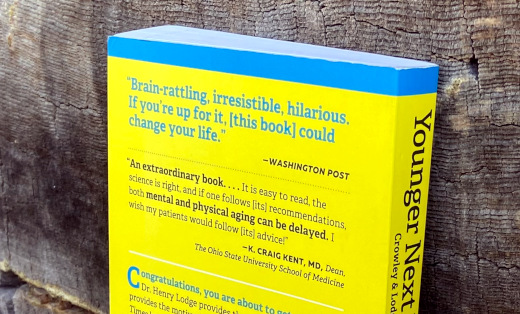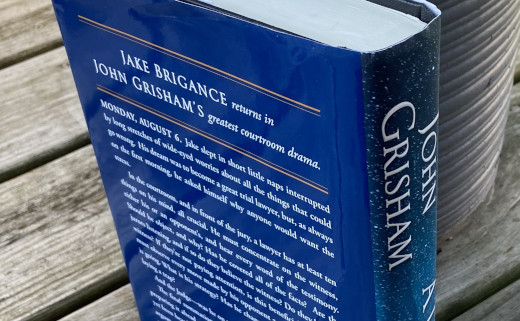My Takeaways From Younger Next Year

They say you shouldn’t judge a book by its cover, but what about by its title? When I recently learned about the book Younger Next Year I was clearly intrigued. With all going on in my own life with my health, I just had to take a look at this book. So I bought a copy and made it a priority to read it cover-to-cover.
The copy I acquired was the latest version of Younger Next Year, which was the 15th anniversary edition (clearly I was late to the game on this book and its universe, but I digress). It was written by patient/doctor duo Chris Crowley and Dr. Henry Lodge, and new to this edition were passages on brain health by neurosurgeon Dr. Alan Hamilton.
Younger Next Year is a book geared for men by men, talking about being men getting older. It’s written in a conversational style one would expect from guys talking to each other while sitting in the stands at game or at a local watering hole. Chapters alternate between Crowley and Dr. Lodge, where the former talks in more general terms and the latter provides the medical wisdom and science behind the former. Right out of the gate this format worked for me.
So was Younger Next Year all style and no substance? Hardly, as you can see from a paired down list of my key takeaways from it.
Workout Hard 6 Days a Week – This is pounded through the book, and when not directly stated over and over again it is implied. We not only need to keep moving, but moving to the point we are sweating, gaining muscle, keeping flexible and so on. It’s something I knew as our bodies, which really haven’t evolved much since the caveman and cavewoman days, are not designed to be sedentary. Where I know I need to do this more often, I wish I could. To aid the effort I joined a gym. After a good start I have not kept it up… he types as guilt falls over him.
What We Eat Is Equally Important – This is something I have known and been practicing for years and especially in the last one. You can’t purely exercise weight off. Garbage-in, garbage-out as we say in the computer world applies to our bodies and we’re soaking in ultra-processed, over-engineered stuff to consume that is passed off with clever marketing as food. By eating real food and intermittent fasting I have lost 60 pounds in the last year. As my fellow New Englander Robert Frost said, “… and miles to go before I sleep” and I do have much more to lose. In the meantime I am going to enjoy the extra room I have in an airplane seat among other benefits.
You Can’t Do It Alone – We are warm-blooded animals that have a limbic brain. When I the authors say alone they don’t just mean being with a partner but close friends and acquaintances as well. I would add to this the “right” doctor that truly is going to help you on your journey. The reality there is whatever doctor is likely out-of-network from your health insurance.
Aging vs. Decaying – Where the former will just happen, something can be done about the latter. Each of these is often mistaken for the other. By following the advice in the book, where you will get older, could your body actually get younger?
The only thing I didn’t like about Younger Next Year is that it could get a little too repetitive. However I get it – they are trying to drive home a point, and it did not distract me from enjoying this book. I highly recommend Younger Next Year for anyone Gen X and older, as well as those just behind us as they will be here sooner than they think. There’s also a woman’s version of the book, and I am interested if any of my female readers read a copy of it.
As for whom I am giving this book to, it is going to a good friend who is not too far behind me in years and should know well about the idea of vigorous exercise. It will be good timing to send to him as he has been getting self-reflective lately.
This is from The Hot Iron, a journal on business and technology by Mike Maddaloni.
Did you enjoy this? Subscribe to The Hot Iron by RSS/XML feed or Read by Email
Book Take-Aways • (0) Comments • PermalinkTake Fives

So I have more five dollar bills in my wallet these days.
Why? The genesis for this was not having smaller bills on me and as a result costing me more than I hoped when tipping on a recent trip to Chicago. I was staying at a nicer hotel and at almost every turn there was someone to tip. As most ATMs today just give $20 dollar bills, that was all I had. Needless to say it made me look like a really generous guy.
Inflation Hits Gratuity
With the prices of everything going up over the last several years, restaurants have not been immune from this. It is evident in not only the menu prices being higher, but the suggestions for what to tip the wait staff are right up there too. You know those “tipping tables” you see at the bottom of your bill, the ones that list percentages and the dollar amounts to make it “easier” for you to tip? In the past they would likely offer 15% and 20%, and maybe sometimes 25%. These days I am seeing them starting at 18% and sometimes going as high as 30%! That, and more restaurants are automatically adding a tip on parties larger than 4 plus that tipping table too. Clearly restaurant staff are being hit by inflation like the rest of this, and with the overall check being higher, many diners are likely not tipping as they used to.
Thus I started carrying fives on me. Doing so was made easier by my new bank’s ATMs offering $5 bills along with $20 and even $1 bills – it also offers $100 bills as well and, though a popular thing to carry on you in Wisconsin I pass on those, but I digress. It allows me to tip appropriately, as well as not look too cheap by handing someone simply a one-dollar bill.
Making It Real
Carrying more cash on me has been something I have actually been doing for a while. From every expense you make being tracked to ginormous bank statements listing those very transactions to having had a few attempts of hacking of my bank accounts in recent years, by using cash more reduces all of this. Not to mention some merchants are passing along to their customers their credit card fees. Several local gas stations are offering cash prices up to 5 cents off a gallon. With filling up 2 cars every week, this adds up quickly, and I’ll take the reduced cost of anything anywhere I can. Even though the stands at the farmers market take cards and accept payments from mobile apps like Venmo, they are always appreciative to take old-fashioned fiat currency.
Deconstructing Carrying Fives
When it comes to inflation we often feel powerless to merely succumbing to it. By carrying five dollar bills on me it is attempt to counter this wave. Seeing cash actually leaving your wallet makes you think about what you are doing with that money, more than a piece of plastic or QR code ever will. By placing a bill in a tip jar or someone’s hand makes the acknowledgement of gratuity more real. One $5 is easier than fishing a couple of ones from your wallet and makes a little more generous statement without going over the top.
This is from The Hot Iron, a journal on business and technology by Mike Maddaloni.
Did you enjoy this? Subscribe to The Hot Iron by RSS/XML feed or Read by Email
QR Codes • Strategize • Thrive • (1) Comments • PermalinkMy Takeaways From A Time For Mercy

You see them everywhere, well at least I do. They are usually together, in a collection on a rack or shelf at a bookstore, department store and always at airport gift shops. The titles are somewhat catchy and who created them are familiar because you have seen them before, even if you don’t have first-hand familiarity with them. If it wasn’t for me getting one of these for Christmas last year. I probably would’ve never entered their world, or at least this soon.
What am I talking about? Where the technical term may be non-fiction novels, I refer to them as “big” novels – stories written by authors who have written many books over the years, and when I mean many I mean in the dozens. Thanks to that gift from my Mother-in-law, I am now proud to say I have read a “big” novel.
My entry into this universe is A Time for Mercy by John Grisham. I was eager to read this because I was always curious to read Grisham, but also because it took an awful lot of room on my already burgeoning bookshelf. It seemed like a good book to take on the road, and when we recently took a family trip – no less on an airline that had no Wi-Fi – this was the perfect opportunity to disconnect from the world and connect with this story.
A Time for Mercy is the fictional tale of a murder case taken on by Jake Brigance, a lawyer in a small Mississippi town in the 1990’s. Grisham himself was a lawyer, I found out afterwards, and this explains its extensive yet enjoyable-to-read detail. So would I have takeaways from such a tale? But of course.
Great storytelling – From the moment of take-off to throughout the trip and to the flight home, I really enjoyed it. This was perfect escape from me and helped me relax while on vacation (I know, me!). There was great storytelling throughout its 400 pages and it was a very compelling read.
Doing the work can make for good reading too – Many times when you take in a story, especially a legal one, it never gets into the grunt work that goes on behind the scenes leading to the main dramatic events. In A Time for Mercy there was sufficient detail of this mundane work woven throughout it. I found it not only important to how the story unfolded but refreshing. Over this same time period my family was binge watching the TV show Suits, which is a perfect example of just the opposite – drama without the detail.
Need to mix in more books from other “big” authors – Fortunately my wife has some of these books on her nightstand so when I get through the myriad on my own bookshelf, I may borrow one or several from her.
A Time for Mercy was an enjoyable read and recommend it to anyone looking for a thematic escape. Even if you are not into legal tales, this tells a good story of those impacted by the case, in and out of the court room. Eager to give this one away due to its size, I sent it to my cousin along with a coffee mug and Starbucks gift card, and my hopes he gets an enjoyable escape when he reads it as I did.
This is from The Hot Iron, a journal on business and technology by Mike Maddaloni.
Did you enjoy this? Subscribe to The Hot Iron by RSS/XML feed or Read by Email
Book Take-Aways • (0) Comments • PermalinkYou Through Someone Else’s Eyes

AI-generated image of someone looking at someone else thru a lens by DALL-E
You may have heard the expression, “you don’t control your brand, your customers do.” This comes from the belief that the perception of a company and its products, despite the efforts they put, will likely come from how they resonate with their customers. This perception may impact a company overall or just to a few customers. There are rare cases where this can be extreme; Bud Light is one that comes to mind. I am aware of this as it has happened to me over the years. I’d like to share one story of how this happened with one client, despite them being a referral from another client.
Referrals are good, right?
One day a very good client told me she was going to connect me to someone who needed help with their Web site. I had redesigned this client’s Web site and added significant dynamic functionality, to which she was very pleased. She however wasn’t specific as to the needs of whom she was referring me to though. I thanked her for the referral and I took it from there. Or so I thought.
The referral was independent contractor who had done some work for my client. I quickly assessed they were very confident in their abilities and spoke very highly of themselves. As we got into the specifics of their needs for their Web site, I didn’t get a strong sense she knew what she wanted despite how confident she was that she did know. In the end it was settled she wanted an unspecified content refresh. I suggested we start on a time and materials basis (aka hourly) and upon agreement I sent a contract. It was signed and we went to work.
As we started I did a top-level assessment and delivered it to her verbally, something I often did for similar projects. The Web site looked good but there were some issues I found, namely a lot of text in images. This was met with a unexpected refusal; even though she complained about having a lack of search engine prominence (tip: text in images is not a good thing for many reasons, especially for being found in search results) she liked text in graphics as it was esthetically pleasing to her.
After much back and forth (looking back, too much back and forth) it was decided to refresh the photos on the Web site, a combination of new and enhancements to existing ones. Though not a graphic designer I did the work myself, for the basics of what I know in PhotoShop seemed sufficient based on the request. When I was done and presented the work, it was picked apart to a level I did not see coming, with the implication I didn’t get at all what she was looking for. So I went back and made further adjustments, to which she was content, and the changes went live. I sent an invoice, she paid, transaction complete.
Along the way I talked with this new client about the full breath of services I offered, to which I got a lukewarm response, but not a definite “no” as she saw a redesign of the entire site sometime in the future. Shortly after my work for her was done, she referred to someone else, another independent contractor, who wanted some unspecified work done to their Web site. It was starting to feel like déjà vu all over again, both from their approach and my own. Despite this, I still reached out, and my hunch turned out to be correct. I did some small work for this new referral, but eventually turned down additional work.
While I was the midst of doing the final work for that second referral, I saw the first one relaunched their Web site, clearly working with someone else. Despite the fact I articulated my services, something did not resonate with her that I could do a full redesign, just small updates. That was my gut feel and I never did bother asking her why. As you might guess, I didn’t do any other work for her after that.
Deconstructing How Other See Us
This was a truly learning experience. I needed to stick to and continuously refine my approach on vetting clients, especially from referrals, and taking on new work. I burned a lot of my time with both of these referrals, something I didn’t see when I was in the midst of negotiating and working with them. They weren’t, fortunately, my only clients, as there were plenty of others I was working with the way I wanted to work with a mutual benefit for all.
This is from The Hot Iron, a journal on business and technology by Mike Maddaloni.
Did you enjoy this? Subscribe to The Hot Iron by RSS/XML feed or Read by Email
(0) Comments • PermalinkMy Takeaways From Animal Farm

"You should read Animal Farm..." was advise someone gave me a while back, that someone I now forget who they were. As I am someone who enjoys curling up with paper book - never an eBook - I often get such suggestions. However this one continued with, "... it's a short book, but don't let its size fool you." With a work trip earlier this year, I thought no time like the present to finally tap into this recommendation.
Animal Farm was written by George Orwell and published in 1945, four years before his most famous novel, 1984. It is the story of anthropomorphic animals on a farm who rise up against the humans who run the farm and proceed to take it over. Where I was always aware of the general premise of the story and that there was a cartoon movie made from the book, that was about it. My assumption that I thought it was more of a children's story was debunked quickly as I flew back to the US East Coast absorbing this page-turner of a story.
So what could I possibly takeaway from a book that featured talking pigs and horses?
To Russia with Disdain – The plot of Animal Farm, though satirical, is based on Orwell's perception and objection of Joseph Stalin and the Communist Soviet Union of that era. This was something I first learned of in the introduction of the book and not going into it. Where to some this may be considered a spoiler, it actually helped me frame the actions and behaviors of the farm animals as I traveled across the book’s pages.
Checks and balances – When power is centralized, there is the chance that little can be done to resist or change it. The same can be said for animals that act like people. Interestingly I think about this fact as much today when I read the news as I did when I read Animal Farm and was thinking about the time it was written.
Indoor and Outdoor talk – This concept cane from introduction of the book by author Tea Obreht when she was comparing 1940’s Soviet Union to when she grew up in 1980’s Yugoslavia. It literally refers to how people would talk about topics – mostly politics – differently inside their house and with family as compared to what they shared with others in the outside world. This of course harkens back to the oppressive governments in each of those times and places and how people would be turned in by neighbors for their resistance (or merely suspicion) to the government, usually to their ultimate demise.
Animal Farm is a very creative way to tell a story. Remove the fact that you are reading about farm animals, it is sad tale of human interaction. Add back in the animal element, and you have a tale that starts out jovial and encouraging but quickly turns sour.
I enjoyed reading Animal Farm and I recommend it to anyone as it is a classic with deep meaning. I decided to be in the moment when I finished it and left in the airplane's seat-back pocket, hoping serendipity would prevail and someone would notice and do as I did and read this classic, it’s lines and between them.
This is from The Hot Iron, a journal on business and technology by Mike Maddaloni.
Did you enjoy this? Subscribe to The Hot Iron by RSS/XML feed or Read by Email
Book Take-Aways • (0) Comments • Permalink
